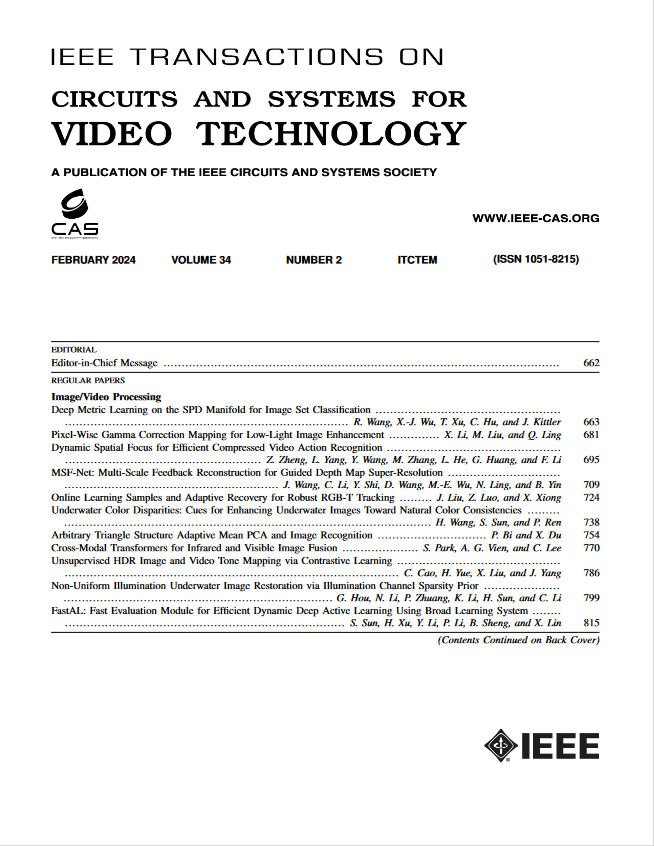基于偏振成像优化模型的水下图像恢复方法
IF 8.3
1区 工程技术
Q1 ENGINEERING, ELECTRICAL & ELECTRONIC
IEEE Transactions on Circuits and Systems for Video Technology
Pub Date : 2024-12-09
DOI:10.1109/TCSVT.2024.3512600
引用次数: 0
摘要
偏振成像由于能够有效地去除背散射光,在水下图像恢复中得到了广泛的应用。然而,现有的偏振成像方法通常假设后向散射的偏振度(DoP)在空间上是恒定的,并从背景区域进行估计,限制了其实际应用。为了解决这些问题,我们提出了一种基于偏振成像优化模型(PIOM)的水下图像恢复方法。首先,通过融合后向散射光的DoP和偏振角(AoP),建立了一种新的偏振成像模型。其次,提出了一种基于PIOM的自适应粒子群局部优化方法(APSLO)。该方法将图像分解成小块,利用目标优化函数估计局部最优融合参数。此外,我们提出了一种鲁棒多项式空间拟合方法,以减少块伪像和噪声干扰,实现全局最优融合参数。最后,充分考虑伽玛校正的优点,提出了一种平衡亮度和对比度的自适应对比度增强方法。实验结果表明,我们的PIOM有效地消除了后向散射,同时保留了更精细的细节、颜色和轮廓。代码和数据集可在https://github.com/liyafengLYF/UIRPIOM上获得。本文章由计算机程序翻译,如有差异,请以英文原文为准。
An Underwater Image Restoration Method With Polarization Imaging Optimization Model for Poor Visible Conditions
Polarization imaging is extensively employed in underwater image restoration due to its effectiveness in removing backscattered light. However, existing polarization imaging methods generally assume the degree of polarization (DoP) of the backscattering is spatially constant and estimate it from the background region, limiting their practical applications. To address these challenges, we propose an underwater image restoration method based on a polarization imaging optimization model (PIOM). First, we develop a novel polarization image formation model by fusing the DoP and angle of polarization (AoP) of backscattered light. Second, we introduce an adaptive particle swarm local optimization (APSLO) method based on the PIOM. This method decomposes the image into small blocks and employs an objective optimization function to estimate the local optimal fusion parameters. Additionally, we propose a robust polynomial spatial fitting method to reduce block artifacts and noise disturbances, achieving globally optimal fusion parameters. Finally, we fully consider the advantages of gamma correction, and propose an adaptive contrast enhancement method to balance brightness and contrast. Experimental results show that our PIOM effectively removes backscattering while preserving finer details, colors, and contours. The code and datasets will be available at https://github.com/liyafengLYF/UIRPIOM .
求助全文
通过发布文献求助,成功后即可免费获取论文全文。
去求助
来源期刊
CiteScore
13.80
自引率
27.40%
发文量
660
审稿时长
5 months
期刊介绍:
The IEEE Transactions on Circuits and Systems for Video Technology (TCSVT) is dedicated to covering all aspects of video technologies from a circuits and systems perspective. We encourage submissions of general, theoretical, and application-oriented papers related to image and video acquisition, representation, presentation, and display. Additionally, we welcome contributions in areas such as processing, filtering, and transforms; analysis and synthesis; learning and understanding; compression, transmission, communication, and networking; as well as storage, retrieval, indexing, and search. Furthermore, papers focusing on hardware and software design and implementation are highly valued. Join us in advancing the field of video technology through innovative research and insights.

 求助内容:
求助内容: 应助结果提醒方式:
应助结果提醒方式:


